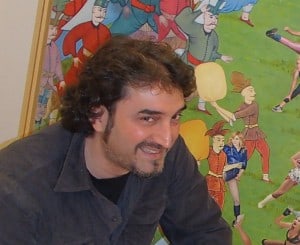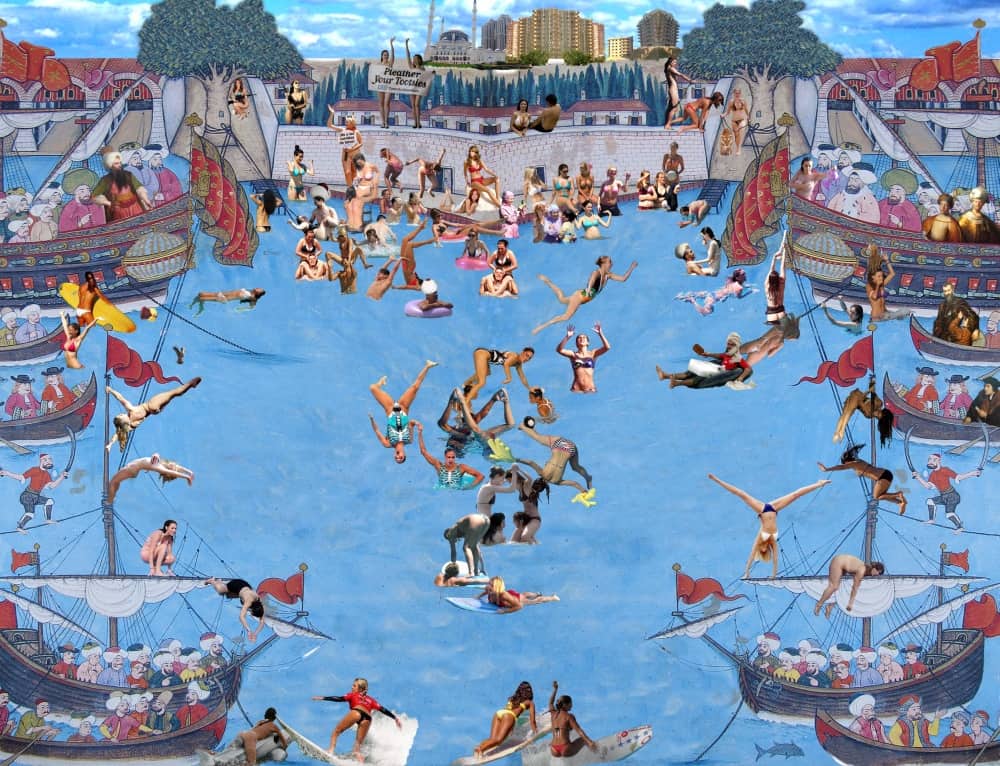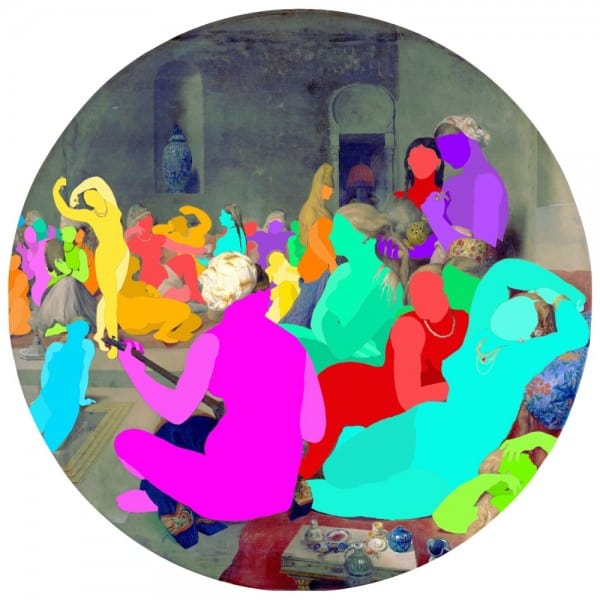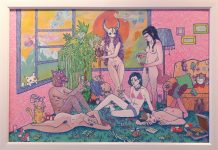By Sam Gimson

‘Where’s Wally?’ was my intended opening question when I spoke with Gazi Sansoy about his paintings this weekend. His current show, ‘Who Are We?’, is on now at Gallery Ilayda until 11 May. Of course, whether my joke is at all funny relies on one’s familiarity with the given cultural point of reference, which, in this case, can confuse even native English speakers – in British English we say Wally, whereas Americans use the name Waldo. However, the iconography that Gazi Sansoy uses so abundantly in his pictures has that universality unique to visual forms of humour.
To those of us with some interest in Western Art History, Ottoman culture, Kim Kardashian and bare-breasted women, his social commentary seems poignantly sardonic. His strong sense of visual humour is absurd and subversive – what better device is there than humour to say things that might otherwise be un-sayable?
***
Sam: Your pictures remind me of Terry Gilliam’s collage animations that he made for Monty Python. Is there anyone in particular who has influenced your sense of pictorial humour?
Gazi: Not especially – it’s intuitive. When you put a picture of Kim Kardashian next to an Ottoman miniature, the humour’s there already. I don’t have to work on it a lot.
[These collage paintings to which he is referring are from one of two bodies of work represented in this solo exhibition. He is referring specifically to the series entitled ‘Miniatures’, which are assemblages of disparate images taken from Ottoman miniatures, European old masters and popular culture, arranged and then painted in a photo-realistic manner.]

Sam: What is your process when designing such busy compositions?
Gazi: I have a big folder of images on my computer to which I add about 20 to 30 pictures daily, taken from the internet. From there I make the collages on my computer. The design stage will take between one and one and a half months. So much of it is about editing and re-editing.
Sam: And so the design stage and the execution of the painting are utterly separate processes for you?
Gazi: The design stage is all about thinking and the execution is just work. I won’t change the composition once I start painting.
[The other body of work is his ‘Faceless’ series. Here he either creates paintings after European artists such as Raphael, and Leonardo, colouring over the flesh of the figures with bright, block colours, or paints over printed reproductions.]
Sam: Can you explain your reasoning behind the Faceless series?
Gazi: I started painting the Miniatures series choosing to include images of Renaissance paintings, colouring over the skin with bright acrylic paint. The contrast between the muted colours of these old paintings and the synthetic pinks and yellows that I superimposed was more apparent when presented as a picture by itself. This contrast is what I am interested in – aesthetically and conceptually.
Sam: And you see this discrepancy as being metaphorical of our own times? Living in Istanbul, do you believe that modern trends sit well against the city’s historical characteristics?
Gazi: Well it’s a sort of tragic comedy, nothing is organised well in this city and the past and present rarely meet here in a positive way. For example, what they’re doing with Emek movie theater [which is the biggest/oldest cinema in Turkey], the bottom floor will be turned into a shopping mall and the cinema is being moved upstairs. This is just one example.

Sam: One of the pictures that I am particularly struck by from the Faceless series is your painting after Jean Auguste Dominique Ingres of the Turkish Bath. Do you see Ingres’ paintings as being typical of Western exoticism, representing a French imperialist belief in the West’s moral supremacy?
Gazi: Well it was just the fashion of that time, I’m not sure if he would have thought so much like that. I saw an exhibition of Ingres’ paintings along with similar French Orientalist painters such as Gerard at the Musée d’Orsay, and I didn’t feel this way about them. While in the West people were discovering things about the universe, we are shown to have been relaxing in bath houses, enjoying life. Maybe this was something to criticise for them.
Sam: Considering the nature of your work, I was wondering – have you ever come up against government censorship?
Gazi: I showed my paintings at an Istanbul art fair in 2010 and afterwards received a phone call from an art gallery in Ankara. This lady started interrogating me, asking why Mevlevis are dancing with naked women in my pictures. She was talking at me like a machine gun: what is going on in these pictures, why are all these people there together? I stopped her and said, “Wait, don’t you know the saying by Rumi ‘come come whoever you are’?” She went on to inform me that this telephone conversation would be reported to someone else and that I should give the same explanations if anyone else comes to ask about it. But to be honest I’m surprised there haven’t been some repercussions considering how fundamentalist the country is becoming. My work is critical and I was waiting for more of a reaction; I thank god it never came.
Sam: But do you think this is because visual artists are less censored here due to the financial perks brought by Turkey’s booming art market?
Gazi: Well, luckily the government is not too interested in art, it’s not their territory and therefore their intervention is limited. I think that with a more public form of art, such as with the building of new mosques (or at least new mosques in old styles), then there is more interference. Or maybe you heard about the Sculpture of Humanity in Kars; the government had it pulled down in 2011.
***
For anyone who thought that Pop art was just a passing movement happening briefly in the 60s, Sansoy reminds us that we still live in that same society, characterised by decadence and superfluity, and that we have lost contact with our past, despite some people’s futile efforts to recreate it. From an artistic point of you, however, I’m not sure that the graphic visual language of our times, of mass photographic reproduction, is an articulate enough language through which to meaningfully comment on itself.
This interview was condensed and edited to accommodate the process of translation.
Gazi Sansoy’s solo show “Who Are We?”” continues from until 11 May at Gallery Ilayda. Click here for more details.










original